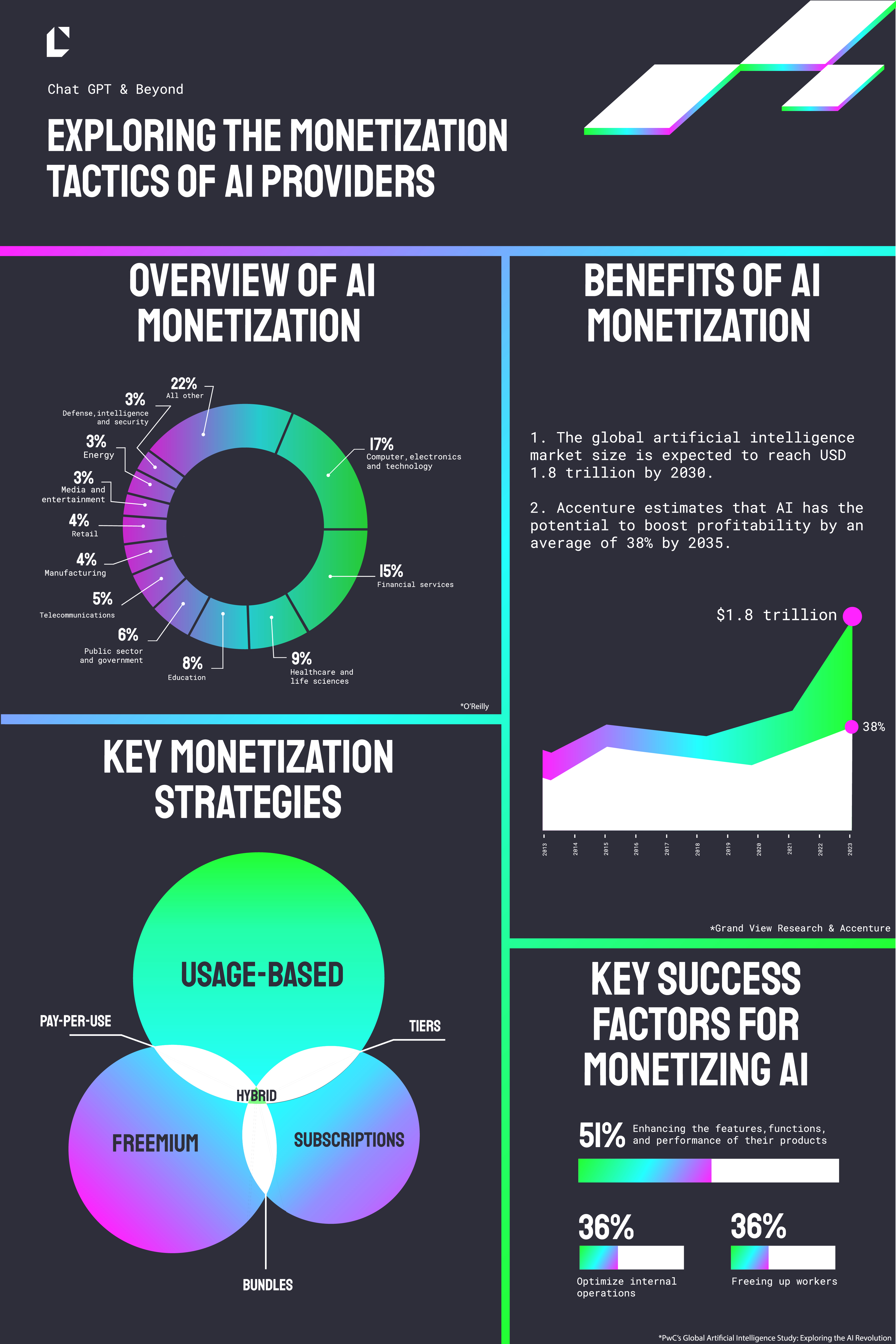Artificial intelligence (AI) has evolved from futuristic novels to a transformative force, revolutionizing industries and enhancing efficiency. Chat GPT, a notable AI solution, has significantly bridged information gaps and revolutionized computing. According to Grand View Research, the global AI market is projected to reach $1,811.75 billion by 2030, with a CAGR of 37.3% from 2023 to 2030. As AI demand grows, understanding how providers monetize their services is crucial. This blog explores AI monetization strategies, with a focus on Chat GPT as an exemplary case.
The Revolution: AI Providers in the Marketplace
AI providers are transforming the business world by employing advanced machine learning techniques and harnessing vast data sets. These companies have developed cutting-edge solutions impacting industries such as healthcare, finance, and retail. In this dynamic landscape, AI providers excel in offering bespoke solutions tailored to client needs, driving economic development and ushering in a new era of smarter, more productive businesses. Their growth and influence across various sectors highlight the pivotal role of AI in shaping the future.
Understanding AI Monetization
Monetization of AI services involves strategies AI providers use to generate revenue from their products. Dynamic, well-designed pricing models are crucial, enabling clients to maximize value from AI solutions while benefiting consumers exploring AI capabilities. As we delve deeper into AI monetization, Chat GPT serves as a leading example, demonstrating how effective pricing strategies can unlock higher revenue streams and create win-win scenarios for both providers and consumers.

The Case of Chat GPT
Chat GPT has significantly impacted the AI market with its innovative model, revolutionizing customer interaction by accurately understanding and responding to human language. The company employs a usage-based pricing structure for its premium models, charging customers based on the number of tokens consumed in their queries. This approach provides clients with greater control over their expenses, allowing them to pay only for what they use.
Key Success Factors for Monetizing AI Services
Inspired by Chat GPT's success, the critical attributes of a successful AI monetization strategy include:
- Understanding Customer Needs: Comprehend and meet clients' needs by analyzing the target market, identifying pain points, and developing tailored solutions.
- Implementing Flexible Pricing Models: Usage-based pricing grants clients control over expenses, encouraging service adoption with low risk and cost.
- Offering Superior Services: Deliver high-quality AI solutions with superior performance, relevance, and accessibility to drive user uptake and satisfaction. A compelling pricing model further enhances adoption.
The Rise of Usage-Based Pricing in AI Services
AI providers generate revenue by offering solutions to businesses aiming to optimize operations, automate tasks, and leverage data. The profitability of AI services hinges on the pricing models adopted and the extent of AI adoption.
At the forefront is usage-based pricing, where customers pay based on actual consumption. This includes pay-per-use, pay-per-query, token-based consumption, or pay-per-minute. Providers also offer tiered pricing, volume discounts, and bundled pricing to cater to diverse customer preferences. This model aligns costs with usage, encouraging adoption and flexibility.
Pay-per-Use Model: Embrace Flexibility and Cost-Efficiency
The pay-per-use model lets customers pay only for the AI services they use, aligning costs with their needs. ChatGPT by OpenAI exemplifies this model, charging based on the number of tokens processed for both input and output. For instance, a 4K context size costs $0.0015 per 1,000 tokens for input and $0.002 per 1,000 tokens for output.
This model offers flexibility and cost-efficiency, allowing businesses to scale AI usage according to their requirements. It eliminates fixed subscription costs, enabling users to leverage AI services precisely when needed, optimizing spending while unlocking advanced AI capabilities.
Tiered Usage-Based Pricing: Catering to Different Customer Segments
AI providers are adopting tiered usage-based pricing to accommodate various customer segments. This model features multiple usage tiers, each with a different price per unit of consumption. As customers increase their usage, they move to higher-priced tiers that offer additional benefits or features, encouraging more usage by providing greater value at higher levels. This approach caters to individual users and large enterprises alike, capturing a broader range of customers.
For example, Google Cloud's Natural Language API uses tiered pricing based on the number of units processed per month, allowing customers to select a tier that fits their usage needs and budget.
Volume Discounts: Incentivizing Increased Usage
To attract and retain high-usage customers, AI providers offer volume discounts. For example, IBM Watson provides better pricing at higher usage levels for their Watson Assistant service. These discounts encourage increased usage, driving up revenue.
Accenture estimates that AI can boost profitability by an average of 38% by 2035, highlighting the value of AI services. Offering volume discounts incentivizes higher consumption, benefiting both the provider and the customer by maximizing value and efficiency.
Bundled Pricing: Encouraging Cross-Selling and Upselling
Bundled pricing is increasingly popular among AI providers for cross-selling and upselling services. By offering multiple AI services or features at a discounted rate, providers encourage customers to utilize a broader range of services, thereby boosting revenue.
As businesses adopt more AI solutions, bundled pricing allows providers to offer comprehensive packages that meet diverse business needs, capitalizing on the growing demand for integrated AI capabilities.
Hybrid Models: Striking a Balance
Many AI providers adopt hybrid models that blend subscription-based and usage-based pricing. These models offer customers the flexibility to choose between a subscription plan and additional usage-based charges, catering to diverse preferences and needs. This approach attracts a broader customer base, accommodating both regular users and those with occasional or fluctuating AI requirements. By providing this balance, AI providers can satisfy a wide range of users and enhance customer satisfaction.
LogiSense's Realtime AI Learning (RAIL)
Pricing AI solutions is one aspect, but using pricing and usage data to train AI about your business specifics is transformative. LogiSense's RAIL (Realtime AI Learning) technology continuously feeds usage data back into the AI platform, enabling it to learn and provide relevant responses tailored to your business.
RAIL processes and transforms large volumes of data, training AI on unique business interactions, thus personalizing customer experiences. This approach not only highlights AI's flexibility and capability but also demonstrates how to monetize and extract maximum value from AI solutions. RAIL aligns seamlessly with usage-based models, enhancing AI benefits with real-time, clean data.
Conclusion
Advanced usage-based pricing models are essential for AI providers to meet diverse customer needs and maximize revenue. These models also generate valuable data for refining AI through retraining and prompt engineering. By leveraging real-time product and customer interaction data, businesses can transform 'an AI' into 'YOUR AI.'
LogiSense's Realtime AI Learning (RAIL) exemplifies this by harnessing usage data to enhance AI services, driving efficiency, insight, and growth. Whether improving AI performance or adopting usage-based pricing, LogiSense is a valuable partner.
Contact LogiSense today to unlock your business's full potential through innovative monetization strategies.
About the Author
Adam Howatson /
Adam Howatson joined LogiSense as President and Chief Executive Officer in January of 2019, where he also serves as a member of the Board and Board Secretary. Before joining LogiSense, Adam led the go to market and partner functions of Canada’s largest software company, OpenText, as Chief Marketing Officer and SVP.
